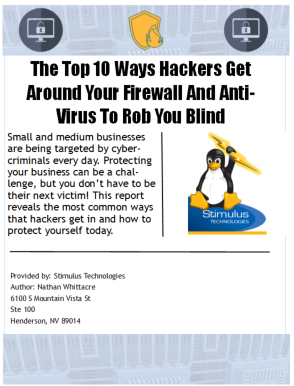By Nathan Whittacre
Founder & CEO, Stimulus Technologies
Veteran IT strategist with 30+ years’ experience helping 800+ businesses—from SMBs to government—leverage technology for growth. MIT-certified in AI for Business Strategy, cybersecurity expert, and author of The CEO’s Digital Survival Guide.

Executive Summary
Year-end is the most dangerous time for cybersecurity because teams are tired, distracted, and overloaded. Fatigue leads to rushed approvals, missed MFA checks, HR/payroll scams, wire fraud, and unpatched systems — exactly what attackers count on during the holidays. Just like the 4x4x48 challenge, discipline and structure matter more than motivation. CEOs must reinforce alignment across finance, operations, IT, and leadership, tighten high-risk processes, and close security gaps before the holiday slowdown.
If you’re unsure whether your cybersecurity posture would hold under year-end fatigue, it’s time for a year-end cybersecurity assessment — the fastest way to clearly understand your current risks and what to fix before January.
There’s a special kind of honesty that shows up when you’re running four miles at 3 a.m. after barely sleeping.
It’s you… your training partner (which gratefully is my wife)… your breath… the cold… and a very persistent question:
“Why am I doing this again?”
My wife and I just wrapped up the 4x4x48 challenge, which is a little bit of David Goggin’s insanity. We ran 4 miles every 4 hours for 48 hours straight. We had the expected stumbles. We were tired. We were under-fueled at times. We negotiated with ourselves more than we’d like to admit. But we finished it, side-by-side, and walked away with a reminder that every CEO needs, especially right now, heading into year-end:
When your employees are tired and overworked, you’re vulnerable.
And December is when companies are the most tired.
The holiday season pulls on every seam inside an organization. Teams are stretched. Inbox discipline softens. People are trying to squeeze in PTO, wrap up projects, close out financials, and survive the sprint to January. This is the window when hackers get bold, social engineering spikes, and “just this once” mistakes happen.
And just like the 4x4x48 challenge, fatigue exposes the truth.
Let’s talk about it.

Why Year-End Cybersecurity Risks Spike (Your Organization’s “3 A.M. Moment”)
The running wasn’t the hardest part of the challenge.
The timing was.
The 3 a.m. and 7 a.m. runs were brutal because our bodies wanted anything except discipline. That same dynamic shows up in businesses this time of year.
Your organization’s “3 a.m. moments” aren’t on a clock, they show up as exhaustion:
- The controller signs a wire approval without double-checking
- An employee clicks a “holiday payroll update” phishing link
- Someone rushes through an MFA prompt without thinking
- HR changes direct deposit for an employee, but the request wasn’t real
- IT postpones a patch because “everyone’s busy”
- Finance downloads an attachment from a vendor because invoices are stacked
- A manager approves a software request without verifying it’s legitimate
Hackers know November and December are open season.
Year-end bonuses, W-2 data, holiday closures, tight deadlines all create the perfect cocktail for a social engineering hit.
People don’t fall for scams because they’re careless.
They fall because they’re tired.
That was us at mile 36. Our bodies weren’t negotiating anymore — they were bargaining.
So do your teams.
The “Nutrition Problem” — How Overload and Under-Resourcing Increase Year-End Cyber Attacks
One thing that surprised me in the challenge was how easy it was to under-fuel or over-fuel. Both led to the same outcome: diminished performance.
Cybersecurity is the same.
During the year-end push, most organizations drift into one of two patterns:
Under-Fueling Security (A Major Year-End Vulnerability)
- No dedicated person watching for threat spikes
- Missed patches because change freezes were implemented
- Slower response times because people are out
- Too many temporary exceptions
- Outdated equipment limping toward January
Over-Fueling (Complexity Creates Its Own Risks)
- Too many projects to complete while “everyone’s out of the office”
- Too many alerts no one looks at
- Too many “security” emails piling up in inboxes
- Too many overlapping systems that confuse end users
Fatigue + complexity is the worst combination for a company.
This is exactly why November thru December produce a spike in:
- Impersonation attacks
- Invoice/ACH redirection fraud
- HR/payroll scams
- Compromised email accounts
- Rushed approvals
- Phishing clicks
Hackers aren’t creative, they’re just being opportunistic. Year-end creates the perfect opportunity.

Cybersecurity Is a Team Sport — Especially During the Holidays
One of the strongest realizations I had during the challenge came late, around mile 44. Everything hurt. My head was spinning from lack of sleep. My legs were basically filing HR complaints. But my wife and I were in it together, and that shared struggle made the whole undertaking feel possible.
Cybersecurity is identical, especially during year-end risk season.
At year-end, when workloads spike and attention spans shrink, you can’t rely on heroics. You need alignment:
- Leadership grounded
- Finance cautious
- Operations steady
- IT supported
- Your IT partner in full stride
When teams are aligned, cybersecurity doesn’t feel like firefighting. It feels like stability.
And going into the holidays, stability is currency.
Structure Protects You When People Can’t
By the time we hit the second night of the 4x4x48, motivation was gone. Only structure remained: Run. Recover. Eat. Hydrate. Nap. Repeat. That structure carried us through fatigue, aches, and low morale. Most businesses lack this structure, especially at year-end when routines fall apart.
The result? Gaps.
Gaps that attackers know how to spot include:
- The missing MFA enforcement
- Not taking time to verify requests for changes
- The admin access someone forgot to revoke
- Not disabling terminated employee access
- The unpatched server put off until Q1
- Not checking geolocation of users on vacation (or are they?)
- The holiday autoresponder that reveals too much
Structure protects you when people can’t. And at year-end, people aren’t functioning at 100%. So, the systems need to take over and ensure the gaps are protected.
Discomfort Now or Pain Later (The CEO’s Year-End Cybersecurity Choice)
The 4x4x48 challenge is not comfortable. But it is clarifying.
The same is true in cybersecurity.
The hardest discipline isn’t technology; it’s creating a secure culture across the organization. And year-end is when leaders must make a choice:
Lean into a little discomfort now or absorb a lot of pain later.
Discomfort now:
- Reinforcing MFA, even when people push back
- Tighter approvals on wire transfers
- Reviewing year-end access rights
- Saying "no" to rushed exceptions
- Scheduling security reminders when teams least want them
- Completing Q4 patching before holidays
- Tightening mailbox rules, filters, and monitoring
Pain later:
- Wire fraud
- Compromised payroll data
- Executive impersonation
- Six-figure recovery bills
- Insurance denials
- January starting with a breach investigation
Most breaches in Q1 trace back to mistakes made between Thanksgiving and New Year’s.
Here are answers to the most common questions CEOs ask during the holiday risk season
- Why do cybersecurity risks increase at the end of the year?
Year-end creates the perfect storm of fatigue, PTO gaps, rushed approvals, and pressure to meet deadlines. These conditions make phishing, payroll scams, and wire fraud far more successful.
- What are the most common holiday-season cyber attacks on businesses?
Payroll redirection scams, fake vendor invoice changes, executive impersonation, phishing emails posing as HR or payroll notices, fraudulent wire requests, and compromised email accounts used to manipulate financial workflows.
- How can CEOs reduce cybersecurity risk during the holidays?
Enforce MFA everywhere, tighten approval workflows, complete year-end patching, limit exceptions, review admin access, and reinforce verification steps across finance, HR, and IT.
- Why is employee fatigue such a major cybersecurity risk?
Fatigue lowers judgment, increases impulsive clicking, reduces verification discipline, and amplifies “just this once” decisions — exactly what social engineers depend on.
- What’s the fastest way to evaluate my company’s cybersecurity posture before year-end?
A focused year-end cybersecurity assessment provides a clear picture of vulnerabilities, identifies fatigue-driven gaps, and outlines high-impact actions to take before January.
The Year-End Cybersecurity Question Every CEO Must Ask
We didn’t finish the 4x4x48 because we were fast.
We finished because we stayed aligned. And we didn’t negotiate with our commitments, even when we were tired.
Heading into the holidays — the tired season — here’s the question every CEO should be asking:
With teams exhausted and attention thin, would your cybersecurity posture hold?
If the answer is “I’m not entirely sure,” that’s not failure.
It’s awareness.
And awareness is the starting line.
The next step is simply clarity. And if clarity is the starting line, then taking action is the next step.
Take the Next Step: Year-End Cybersecurity Assessment
If you want to know exactly where your organization stands heading into the new year, I’d invite you to take 60 minutes for a year-end cybersecurity risk assessment with one of our cybersecurity experts.
It’s straightforward, business-focused, and built for leaders who don’t have time for jargon. You’ll walk away with:
- A clear view of your risk posture
- Where you’re strong
- Where holiday fatigue is creating vulnerability
- The exact steps that will meaningfully reduce risk
Because the truth is simple:
Fatigue is temporary.
Risk isn’t.
And heading into a new year, clarity is one of the most valuable gifts a CEO can give their organization.
👉 Click here to schedule your Year-End Cybersecurity Risk Assessment.







